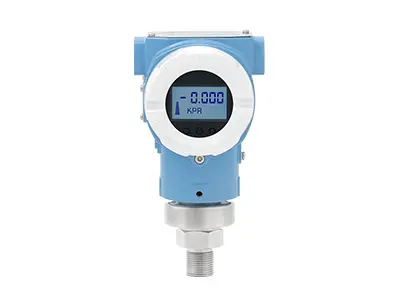Transmitter
The sensor module adopts all-welding technology and has an integrated overload diaphragm, a pressure sensor and a temperature sensor inside. The temperature sensor serves as a reference for temperature compensation. The positive pressure side of the pressure sensor is connected to the high pressure chamber of the sensor diaphragm, and the negative pressure side of the sensor is connected to the low pressure chamber of the sensor diaphragm. The resistance value of the chip changes, resulting in a change in the output voltage of the detection system. The output voltage is proportional to the pressure change, and then converted into a standardized signal output by the adaptation unit and amplifier.
In Lefoo, one of the top pressure transmitter suppliers, Piezoresistive pressure sensors are constructed using the piezoresistive effect of single crystal silicon. Using a single crystal silicon wafer as an elastic element, the integrated circuit technology is used on the single crystal silicon film to diffuse a set of equivalent resistors in a specific direction of the single crystal silicon, and the resistors are connected into a bridge circuit, and the single crystal silicon wafer is placed on the inside the sensor cavity.
When the pressure changes, the single crystal silicon produces strain, so that the strain resistance directly diffused on it changes in proportion to the measured pressure, and then the bridge circuit obtains the corresponding voltage output signal.
1. Remove the flange and check whether the isolating diaphragm of the sensitive part is deformed, damaged or oil leakage occurs.
2. Remove the compensation board without taking out the sensitive parts, and check the insulation resistance of the plug to the housing. When the voltage does not exceed 100V, the insulation resistance should not be less than 100MΩ.
3. Connect the circuit and gas circuit, when the pressure signal is the upper limit of the range, turn off the gas source, and the output voltage and reading value should be stable. If the output voltage drops, it means that the transmitter is leaking, you can check the leak with soapy water.
1. Turn on the power and check the status of the voltage signal at the transmitter output. If there is no output voltage, you should first check whether the power supply voltage is normal; whether it meets the power supply requirements; whether there is a wiring error between the power supply and the transmitter and load equipment. If there is no voltage on the terminal of the transmitter or the polarity is reversed, it can cause the transmitter to output no voltage signal. If the above reasons are excluded, it is necessary to further check whether the components in the circuit of the amplifier board are damaged; whether the connectors of the circuit board are in poor contact, you can compare the measured voltage of the normal instrument with the measured voltage corresponding to the faulty instrument to determine the fault. If necessary, replace the faulty amplifier board. When checking the flow-type transmitter, special attention should be paid to taking anti-static measures for the J-type amplifier board.
2. Turn on the power supply, after the input pressure signal is given, if the output of the transmitter is too high (greater than 10VDC), or the output is too low (less than 2.0VDC), and the output is all the same when changing the input pressure signal and adjusting the zero point and range screws No reaction. For this kind of fault, in addition to checking whether the sensitive parts of the measuring part of the transmitter are abnormal, check whether the "oscillation control circuit part" on the amplifier board of the transmitter works normally or not. The normal peak voltage between high frequency transformer T1-12 should be 25~35VP-P; the frequency is about 32kHz. Secondly, check the working condition of each operational amplifier on the amplifier board; whether the components of each part are damaged or not. Such failures require replacement of the amplifier board.
3. The transmitter has very strict requirements on circuit design and process assembly quality. In actual use, for circuit faults that occur, it is best to contact the manufacturer to replace the faulty circuit board after inspection and confirmation to ensure the long-term working of the instrument. Stability and reliability.
1. The primary element is blocked or the installation form is wrong, and the pressure point is unreasonable.
2. Leakage or blockage of the impulse pipe, residual gas in the liquid filling pipe or residual liquid in the gas charging pipe, and sediment in the flange of the transmitter process, forming a measurement dead zone.
3. The wiring of the transmitter is incorrect, the power supply voltage is too high or too low, and the connection between the indicator head and the terminal of the instrument is in poor contact.
4. It is not installed in strict accordance with the technical requirements, and the installation method and site environment do not meet the technical requirements.
12 Jun 2024
Unlocking Clean Water: How Booster Pumps Enhance Purification Systems29 May 2024
Improving Drug Formulation Accuracy with Stepper Motor Peristaltic Pumps24 May 2024
Meet LEFOO at SPS Italy 202415 May 2024
Precision and Hygiene: Stepper Motor Peristaltic Pumps in the Food Industry English
English  français
français  Deutsch
Deutsch  Español
Español  italiano
italiano  русский
русский  العربية
العربية 
